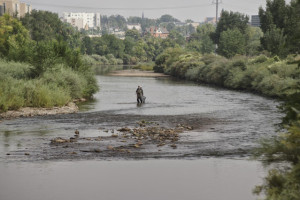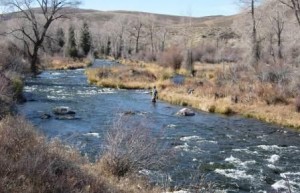Typically when reservoirs are being expanded, it isn't as complicated as expanding Gross Reservoir. The Boulder County body of water may seem like any other reservoir but the idea of adding more water to it needs to take into account an issue happening over 15 miles away- and over the Continental Divide. Gross Reservoir was completed in 1954 as part of a series of intermountain diversions built to store water after it travels from the western slope of the Continental Divide to the eastern slope.
 As the Denver Metro area continues to grow, the water needs rise with it and the unreliable flows from the South Platte River aren't enough to supply roughly 80% of the state's population with water throughout the year. Which is why water from the Upper Colorado River headwaters- in this case the Fraser River- are diverted for Front Range usage.
As the Denver Metro area continues to grow, the water needs rise with it and the unreliable flows from the South Platte River aren't enough to supply roughly 80% of the state's population with water throughout the year. Which is why water from the Upper Colorado River headwaters- in this case the Fraser River- are diverted for Front Range usage.
According to Denver Water, the reservoir expansion also takes on the a water shortage vulnerability. "We need to balance our north and south supply systems. Customers receive 80 percent of their water from the south end of our system. The other 20 percent comes from the north side, through the Moffat Collection System. This imbalance makes the system vulnerable to catastrophic events, such as the Buffalo Creek and Hayman fires, which caused massive sediment runoff into reservoirs on the south side of our system. That runoff forced us to rely heavily on a water-short north system for a period of time. Expanding Gross Reservoir on the north will help balance that inequity."
Gross reservoir holds water originally flowing in the Fraser River that is then pumped into the South Boulder Creek via the 13 mile long Moffat Tunnel at the base of Winter Park Ski Resort. Currently %60 of the native flows are diverted and the reservoir expansion could take up to %20 more.
The Fraser River's health has been in decline and with more water being taken out, the health of the river was in jeopardy. As the flows decrease, the sediment buildup and temperature increases- leaving trout and insect life to diminish.
But thanks to collaboration work between Trout Unlimited and Denver Water, a Learning by Doing initiative was started. Learning by Doing allows Denver Water to remove flows all while keeping the health of the river at the forefront of the issue.
 Learning by Doing requires regular monitoring of stream temperature, riparian vegetation, and aquatic macro-invertebrates. If an environmental problem is detected, Denver Water will provide some financial support and additional flows to help solve the issue. This includes providing the flushing flows the river needs in the spring to clean sediment build up.
Learning by Doing requires regular monitoring of stream temperature, riparian vegetation, and aquatic macro-invertebrates. If an environmental problem is detected, Denver Water will provide some financial support and additional flows to help solve the issue. This includes providing the flushing flows the river needs in the spring to clean sediment build up.
“The fact is, the Fraser and Colorado River have been in decline for many years, and Learning by Doing is giving us a chance to change that trajectory by engaging the key stakeholders on how to work together to best manage the river," said Mely Whiting, TU Counsel. "While more water will be drawn from the river in wetter years and seasons, greater cooperation in managing water – including provisions that provide extra water during low flow periods, and investment of funds in restoration activities – means that we can put the Fraser and the Colorado on a pathway toward better river health."
On June 30, Governor John Hickenlooper officially endorsed the Gross Reservoir Expansion (also known as the Moffat Collection System Project). "This key infrastructure project will serve over 25% of the state's population, add reliability to our public water supply, and provide environmental benefits to both the East and West Slopes of Colorado," said Gov. Hickenlooper. "Denver Water has worked closely with stakeholders in an inclusive public process to develop a balanced and pragmatic approach to environmental protection and water supply development."
 "This project strikes a necessary balance between the water needs of Front Range municipalities and the need to protect healthy flows and fish and wildlife habitat in the Fraser River," said David Nickum, Executive Director of Colorado TU. "The so-called “Learning by Doing” program in the proposal sets up a collaborative process that requires water users to monitor the health of the river in coming years and adjust operations to address unforeseen challenges and opportunities. Moreover, Denver Water has entered into partnerships on the Front Range to ensure that the project alleviates chronic low-flow problems in South Boulder Creek. Both sides of the Divide benefit.”
"This project strikes a necessary balance between the water needs of Front Range municipalities and the need to protect healthy flows and fish and wildlife habitat in the Fraser River," said David Nickum, Executive Director of Colorado TU. "The so-called “Learning by Doing” program in the proposal sets up a collaborative process that requires water users to monitor the health of the river in coming years and adjust operations to address unforeseen challenges and opportunities. Moreover, Denver Water has entered into partnerships on the Front Range to ensure that the project alleviates chronic low-flow problems in South Boulder Creek. Both sides of the Divide benefit.”


